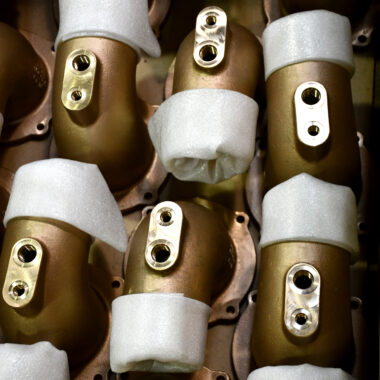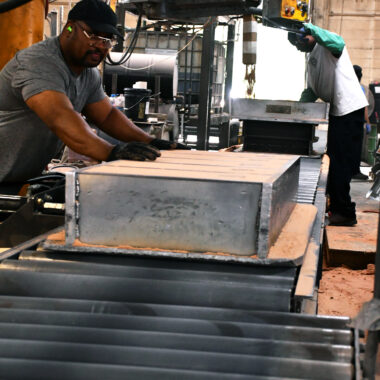Aluminum Casting Demystified: Key Approaches for Success
Aluminum Casting Demystified: Key Approaches for Success
Blog Article
Revealing the Different Sorts Of Aluminum Spreading Processes for Precision Results
Light weight aluminum casting procedures play a critical function in the manufacturing market, using a large selection of strategies to accomplish precision lead to the manufacturing of intricate parts and components. From die casting to sand spreading, investment casting, irreversible mold and mildew casting, and centrifugal spreading, each approach brings its very own collection of ins and outs and advantages to the table. Understanding the nuances of these processes is vital for makers looking for to maximize their production procedures and ensure the best end results. By discovering the distinctive qualities of each spreading technique, a much deeper understanding into the world of light weight aluminum casting can be gained, clarifying the ideal strategy for attaining precision cause numerous applications.
Die Casting Refine
The Pass Away Casting Process is an extremely efficient production technique for producing geometrically intricate metal get rid of high precision and repeatability. This procedure entails compeling liquified steel into a steel mold dental caries under high pressure. The mold, likewise recognized as a die, is normally made in 2 components: the cover pass away fifty percent and the ejector die half. These dies are designed to produce the wanted shape of the end product.
One of the essential advantages of die casting is its ability to produce get rid of thin wall surfaces, elaborate details, and smooth surface areas. This makes it a favored option for markets such as automotive, aerospace, and electronic devices where intricate steel elements are needed. In addition, die casting offers excellent dimensional precision, permitting minimal post-processing demands.
Furthermore, die spreading can be classified right into hot chamber and cold chamber die casting procedures. In hot chamber pass away casting, the molten metal is consisted of in a heater while in chilly chamber pass away casting, the molten metal is ladled into the cool chamber for each and every shot. aluminum casting. Each approach has its own set of benefits and is picked based on the certain demands of the project
Sand Casting Approach
Using a centuries-old method, the sand casting method is a widely utilized procedure in the production market for creating metal components. This approach includes developing a mold made from compressed sand into which liquified metal is poured, enabling it to take the shape and strengthen of the mold cavity. Sand casting is valued for its flexibility, as it can generate a large range of complex sizes and shapes, making it appropriate for different industries such as auto, aerospace, and art factories.
One of the key benefits of sand casting is its cost-effectiveness, specifically for reduced to tool quantity production runs. Furthermore, the sand molds can be recycled several times, reducing product waste and total manufacturing costs. Despite its long history, modern developments in sand spreading strategies, such as using computer system simulations for mold style and 3D printing for developing detailed patterns, have better boosted the accuracy and efficiency of the procedure. On the whole, the sand casting approach continues to be a prominent choice for makers seeking a affordable and dependable means to create high-quality metal components.
Investment Casting Technique

This technique is favored for its capability to generate complex shapes with high precision and great surface finishes. Industries such as aerospace, automobile, and precious jewelry rely on financial investment casting for components that call for elaborate details and limited tolerances. The process permits affordable production of tiny to medium-sized parts in various products, making it a versatile choice for makers looking for precision results.
Permanent Mold Spreading
With a concentrate on creating metal elements via a recyclable mold, Permanent Mold Spreading offers an alternative method to the complex accuracy of financial investment spreading. aluminum casting. This method, also called gravity pass away casting, includes using an irreversible metal mold typically made from steel or cast iron. The mold and mildew is pre-heated before the liquified steel is poured right into it, permitting faster solidification contrasted to sand casting
Permanent Mold Casting enables the manufacturing of high-grade, dimensionally accurate components with a great surface area finish. By using a recyclable mold and mildew, suppliers can attain expense financial savings gradually as the mold can be utilized several times without considerable damage. This procedure is perfect for high-volume manufacturing runs where consistency and performance are essential.
One of the essential benefits of Permanent Mold Casting is its ability to generate complex shapes and elaborate designs easily. aluminum casting. The approach is extensively used in the auto, aerospace, and electronics markets for making elements such as engine components, warm sinks, and structural elements

Centrifugal Casting Method
The Centrifugal Spreading Approach is a technique that entails revolving a mold and mildew at broadband while putting liquified metal right into it. This procedure utilizes centrifugal force to distribute the liquified steel evenly along the walls of the mold, leading to a high-grade, dense casting. The centrifugal pressure presses impurities and gases in the direction of the inner size of the spreading, causing a cleaner end product with boosted mechanical homes.
Among the vital advantages of centrifugal casting is the capability to generate disk-shaped or cylindrical components with a fine-grained framework that boosts the mechanical buildings of the spreading. This method is particularly suitable for creating in proportion components such as tubes, pipelines, and rings. Additionally, centrifugal casting offers the benefit of being a cost-effective procedure with fairly reduced tooling prices contrasted to various other casting approaches.
Conclusion
In verdict, recognizing the numerous sorts of aluminum casting processes is important for accomplishing precise outcomes in manufacturing. Each approach browse around here has its own benefits and constraints, making it crucial to select the most suitable process based upon the certain demands of the job. Whether it is pass away spreading, sand spreading, financial investment casting, long-term mold and mildew spreading, or centrifugal casting, selecting the appropriate technique can result in cost-efficient and high-quality manufacturing results.
From die casting to sand spreading, financial investment spreading, long-term mold and mildew spreading, and centrifugal casting, each approach brings its very own collection of benefits and details to the table. By checking out the distinctive features of each casting approach, a deeper understanding right into the world of aluminum casting can be gotten, losing light on the optimal technique for accomplishing accuracy outcomes in numerous applications.
In hot chamber pass away spreading, the liquified steel is contained in a heating system while in cold chamber die casting, the molten steel is ladled right into the chilly chamber look at these guys for each shot.With a focus on developing steel elements via a recyclable mold, Irreversible Mold Spreading uses an alternative method to the intricate accuracy of financial investment spreading. Whether it is die casting, sand casting, investment casting, irreversible mold spreading, or centrifugal casting, selecting the right method can lead to economical and high-quality production results.
Report this page